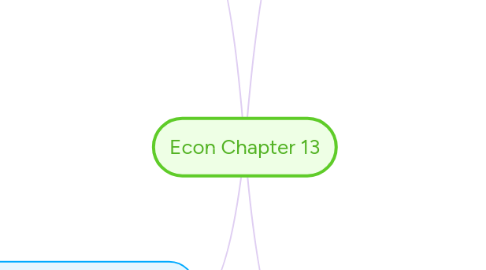
1. 13.2--How Do Economists Measure the Size of an Economy?
1.1. Nominal gross domestic product is the value of all final goods and services produced during a given year, expressed in current prices.
1.1.1. Per capita GDP is calculated by dividing a country’s GDP by its population. The result —a country’s average economic output per person
1.1.1.1. The Human Development Index is an economic indicator favored by the United Nations. It looks beyond a country’s GDP to gain a broader perspective on well-being
1.1.1.1.1. The Happy Planet Index does not include any measure of GDP. Instead it measures the degree to which a country provides well-being to its people and the planet
1.2. The main measure of the size of a nation’s economy is its gross domestic product. GDP is an economic indicator that measures a country’s total economic output
1.3. A steadily growing GDP is generally considered a sign of economic health.
1.4. Economists typically calculate GDP by measuring expenditures on goods and services produced in a country. They divide the economy into four sectors: households, businesses, government, and foreign trade.
1.5. Limitations of GDP as an Indicator of Economic Health: GDP leaves out unpaid household and volunteer work. GDP ignores informal and illegal exchanges. GDP counts some negatives as positives. GDP ignores negative externalities. GDP places no value on leisure time. GDP says nothing about income distribution.
2. 13.3--What Does the Unemployment Rate Tell Us About an Economy’s Health?
2.1. Like the GDP, the unemployment rate is a useful indicator of the health of an economy. In general, a high unemployment rate means the overall health of the economy is poor.
2.2. 4 types of Unemployment
2.2.1. Frictional Unemplyment
2.2.2. Structural Unemplyment
2.2.3. Seasonal Unemplyment
2.2.4. Cyclical Unemplyment
2.3. When an economy reaches full employment, jobs exist for everyone who wants to work, even though a certain percentage of those jobs and workers will not yet have been matched together. Economists call this percentage the natural rate of unemployment.
2.3.1. Employed. Members of the labor force who have jobs are classified as employed.
2.3.1.1. Unemployed. Members of the labor force who are jobless, but are looking for work, are classified as unemployed.
2.3.1.1.1. Not in the labor force. Everyone who is eligible to be in the labor force but is neither working nor looking for work is classified as not in the labor force.
2.3.1.1.2. The underground economy is made up of people who earn income from gambling, drug dealing, and other illegal activities
3. 13.4--What Does the Inflation Rate Reveal About an Economy’s Health?
3.1. The cost in current dollars of all the basic goods and services that people need is the nominal cost of living.
3.2. The German experience was proof, if any was needed, that runaway inflation can send an economy into a tailspin. That is why economists keep a close eye on a third economic indicator: the inflation rate.
3.3. The BLS tracks inflation by gathering information on Americans’ cost of living.
3.4. Consumers pay nominal costs with nominal wages, or wages based on current prices. As prices go up, wages generally go up as well. By using the CPI to adjust for inflation, economists can calculate real wages and compare them
3.5. The BLS relies on the consumer price index to estimate the level of inflation in the United States each month. However, critics point to several biases that may distort the CPI, making the reported inflation rate less than accurate.
3.6. The inflation rate is the percentage increase in the average price level of goods and services from one month or year to the next
3.6.1. The consumer price index (CPI) is a price index for a “market basket” of consumer goods and services
3.6.1.1. The real cost of living is the nominal cost of basic goods and services, adjusted for inflation
3.6.1.1.1. In the United States we have come to expect a certain amount of gradual inflation, or creeping inflation
4. 13.5--How Does the Business Cycle Relate to Economic Health? *Must include image of Business Cycle
4.1. 1) A period of economic growth is known as an expansion. During this phase of the business cycle, economic activity generally increases from month to month.
4.1.1. 2) The point at which an expansion ends marks the peak of the business cycle. At that peak, economic activity has reached its highest level. The peak also marks the start of a decline in economic activity
4.2. The business cycle consists of four phases. These phases include a period of growth and a period of decline, as well as the turning points that mark the shift from one period to the next.
4.2.1. 3) Following the peak comes the contraction phase of the business cycle. A contraction is a period of general economic decline marked by a falling GDP and rising unemployment
4.3. The lowest point of a contraction is called the trough
4.3.1. Measures that consistently rise or fall several months before an expansion or a contraction begins are called leading economic indicators.
4.3.1.1. Coincident economic indicators are measures that consistently rise or fall along with expansions or contractions.
4.3.1.1.1. Measures that consistently rise or fall several months after an expansion or a contraction are known as lagging economic indicators
